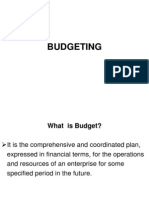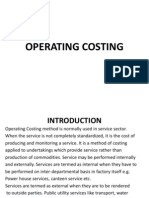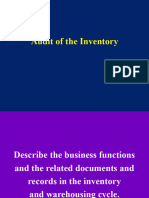0 ratings0% found this document useful (0 votes)
170 viewsOperating Costing Presentation
- Operating costing is used to compute the cost of services offered by organizations in service industries like transportation, electricity generation, hotels, and canteens.
- The main objectives are to determine the appropriate cost unit for each industry and collect costs under fixed, semi-fixed, and variable cost headings.
- For transportation organizations, costs are categorized as fixed costs like licenses and salaries, variable costs like fuel, and maintenance costs. The cost unit is cost per ton-kilometer or passenger-kilometer carried.
- Electricity generation uses power house costing with the cost unit as cost per kilowatt-hour generated. Hotels and canteens determine the cost per meal or other unit
Uploaded by
MahfuzulCopyright
© © All Rights Reserved
Available Formats
Download as PPTX, PDF, TXT or read online on Scribd
0 ratings0% found this document useful (0 votes)
170 viewsOperating Costing Presentation
- Operating costing is used to compute the cost of services offered by organizations in service industries like transportation, electricity generation, hotels, and canteens.
- The main objectives are to determine the appropriate cost unit for each industry and collect costs under fixed, semi-fixed, and variable cost headings.
- For transportation organizations, costs are categorized as fixed costs like licenses and salaries, variable costs like fuel, and maintenance costs. The cost unit is cost per ton-kilometer or passenger-kilometer carried.
- Electricity generation uses power house costing with the cost unit as cost per kilowatt-hour generated. Hotels and canteens determine the cost per meal or other unit
Uploaded by
MahfuzulCopyright
© © All Rights Reserved
Available Formats
Download as PPTX, PDF, TXT or read online on Scribd
You are on page 1/ 18
Operating Costing
Professor Mahfuzul Hoque PhD
Department of Accounting & Information Systems, University of Dhaka
Introduction
Cost Accounting has been traditionally associated
with manufacturing companies. However in the
modern competitive market, cost accounting has
been increasingly applied in service industries like
banks, insurance companies, transportation
organizations, electricity generating companies,
hospitals, passenger transport and railways,
hotels, road maintenance, educational
institutions, road lighting, canteens, port trusts
and several other service organizations.
What is Operating Costing?
The costing method applied in these
industries is known as Operating Costing.
According to the Institute of Cost and
Management Accountants [UK] operating
costing is, that form of operating costing
which applies where standardized services are
provided either by an undertaking or by a
service cost center within an undertaking.
Nature of Operating Costing
The main objective of operating costing is to
compute the cost of the services offered by the
organization.
For doing this, it is necessary to decide the unit of
cost in such cases. The cost units vary from
industry to industry. For example, in goods
transport industry, cost per ton kilometer is to be
ascertained while in case of passenger transport,
cost per passenger kilometer is to be computed.
The next step is to collect and identify various
costs under different headings. The headings
used are,
Fixed or standing charges
Semi-xed or maintenance charges
Variable or running charges.
One of the important features of operating
costing is that mostly such costs are xed in
nature. For example, in case of passenger
transport organization, most of the costs are xed
while few costs like diesel and oil are variable and
dependent on the kilometers run.
Transport Organization
Transport undertakings include goods
transport organizations as well as passenger
transport organizations. The cost unit is either
ton kilometer or passenger kilometer. The
meaning is cost of carrying one ton over a
distance of one kilometer or cost of carrying
one passenger for a distance of one kilometer.
The costs are shown under the following
heads.
Standing Charges or Fixed Costs: These are the xed
costs, which remain constant irrespective of the
distance travelled. These costs include the following
costs.
License fees and insurance
Salaries of drivers, cleaners and conductors
Garage costs which include garage rent and
other relevant expenses
Depreciation of the vehicle and other assets
Taxes applicable
Any other fixed charge like administrative
expenses etc.
Variable Costs or Running Costs: These costs include,
Petrol and diesel
Oil
Grease
Any other variable cost
Maintenance Charges:
These charges include expenses like repairs and
maintenance, tyre, and other charges connected
with maintenance like servicing of the vehicles etc.
The cost sheet for transport organizations can be
prepared in the following manner.
Particulars Particulars
A] Standing Charges/Fixed Charges
Insurance
License/Permit fees
Salaries of drivers, cleaners etc.
Depreciation
Interest
C] Maintenance Charges
Repairs
Tyres
Spares
Garage charges
B] Running Charges/Variable
Expenses
Petrol/Diesel
Oil
Grease
D] Total Cost
E] Total ton kilometers/passenger
kilometers
XYZ Transport Company Ltd.
Cost Sheet October 2007
Vehicle No: Registration No. Days Operated:
Electricity Generation
Power houses engaged in electricity
generation or steam generation use Power
House Costing. Operating cost statement can
be prepared by identifying the costs
associated with the power generation or
steam generation. Cost unit is different for
electricity generation and steam generation.
For electricity generation, cost unit is cost per
kilowatt-hour while for steam it is lb.
Hotels and Canteens
Operating costing can be used effectively in
hotels and canteens. it is necessary to
compute the cost in both the cases to find out
the profit or loss at the end of a particular
period. In this case, the costs associated with
different products offered should be identified
and cost per unit should be worked out. The
cost unit may be number of meals served or
any other dish offered to the customers.
Problems and Solutions: [1]
A lodging home is being run in a small hill
station with 50 single rooms. The home offers
concessional rates during six off- season
months in a year. During this period, half of
the full room rent is charged. The
managements prot margin is targeted at
20% of the room rent. The following are the
cost estimates and other details for the year
ending on 31st March 2006. [Assume a month
to be of 30 days].
1. Occupancy during the season is 80% while in the
off- season it is 40% only.
2. Expenses:
Staff salary [Excluding room attendants]
$2,75,000
Repairs to building $1, 30, 500
Laundry and linen: $40, 000
Interior and tapestry: $87, 500
Sundry expenses: $95, 400
3. Annual depreciation is to be provided for
buildings @ 5% and on furniture and equipment
@ 15% on straight-line basis.
4. Room attendants are paid $5 per room day on
the basis of occupancy of the rooms in a month.
5. Monthly lighting charges are $120 per room,
except in four months in winter when it is $30 per
room and this cost is on the basis of full
occupancy for a month.
6. Total investment in the home is $100 lakhs of
which $80 lakhs relate to buildings and balance
for furniture and equipment.
You are required to work out the room rent
chargeable per day both during the season and
the off-season months on the basis of the
foregoing information
Solution: Before preparing statement of total estimated
costs, some working notes will be required.
A. Computation of Estimated Cost for the year ending 31st
March 2006
Particulars Amount $
Salary 2, 75, 000
Repairs 1, 30, 500
Laundry and linen 40, 000
Interior decoration 87, 500
Depreciation:
5% on $80 lakhs:
15% on $20 lakhs:
$4, 00, 000
$3, 00, 000
7, 00, 000
Miscellaneous expenses 95, 400
Total costs 13, 28, 400
B. Number of room days in a year:
Occupancy during season for 6 months @ 80% [50 X
.80 X 6 X 30] = 7200
Off-season occupancy for 6 months @ 40% [50 X .4 X 6
X 30] = 3600
Total number of room days during a year = 10, 800
C. Attendants salary
For 10, 800 room days @ $5 per day = $54, 000
D. Light charges for 8 months @ $120 per month i.e.
$120/30 = $4 per room day
Light charges for 4 months @ $30 per month, i.e.
$30/30 = Re.1 per room day
Total lighting charges:
During season @ $4 for 7200 days = $28, 800
During off season 2 months @ $4 for 1200 days [2/6 X
3600] = $4, 800
During 4 months of winter @ $1 for 2, 400 days [4/6 X
3600] = $2, 400
Total lighting charges: $36, 000
Note: It is given in the example that during four months of
winter, the lighting is $30 per room, which is 1/4th of the
lighting charges during the remaining period of the year.
Hence, the rate of room day which is $4 will also be 1/4th for
winter period and so it is taken as $.1 per room day.
Statement of Total Estimated Cost
Computation of total Full Room Days
During season: 7, 200
Off-season: 1, 800 [Equivalent to 50% rate of 3, 600 days]
Total Full Room Days: 9, 000
Computation of Room Rent
Cost per room day: $14, 18, 400 /9, 000 = $157.60
Add: Profit margin at 20% of rent or 25% of cost = $39.40
Room Rent = $197.00
Thus, during season, room rent of $197 is to be charged while in the
off-season room rent of $98.50 is to be charged.
Particulars Amount $
Expenses as shown in A above 13, 28, 400
Attendants salary as shown in C above 54, 000
Lighting charges as shown in D above 36, 000
Total cost 14, 18, 400
You might also like
- Business Budget Assignment Shannon MccourtNo ratings yetBusiness Budget Assignment Shannon Mccourt5 pages
- Working Capital Management: A Case Study of OCM: Mr. Rohit KandaNo ratings yetWorking Capital Management: A Case Study of OCM: Mr. Rohit Kanda12 pages
- Chapter 1 Introduction To Cost AccountingNo ratings yetChapter 1 Introduction To Cost Accounting9 pages
- Business Processes in Management Accounting: Solution: Delivery Methods: Duration: Level: LanguagesNo ratings yetBusiness Processes in Management Accounting: Solution: Delivery Methods: Duration: Level: Languages2 pages
- 1-Quantitative Decision Making and Overview PDFNo ratings yet1-Quantitative Decision Making and Overview PDF14 pages
- Application of Service Costing in Hotel Industry100% (1)Application of Service Costing in Hotel Industry5 pages
- Supply Chain Management at Dalmia Cement LTD: Case Analysis-Group 23No ratings yetSupply Chain Management at Dalmia Cement LTD: Case Analysis-Group 235 pages
- Credit Standards Multitech Classifies Customers Into 4 Categories, 1 Through 4. Credit RatingNo ratings yetCredit Standards Multitech Classifies Customers Into 4 Categories, 1 Through 4. Credit Rating1 page
- Product Life Cycle PLC: Managing PLC For ITC-ScissorsNo ratings yetProduct Life Cycle PLC: Managing PLC For ITC-Scissors18 pages
- Chapter No. 3 Marketing Cost and Profitability AnalysisNo ratings yetChapter No. 3 Marketing Cost and Profitability Analysis12 pages
- V Semester Bba Management Accounting-Ratio Analysis: Questions & Answers ContinuedNo ratings yetV Semester Bba Management Accounting-Ratio Analysis: Questions & Answers Continued6 pages
- Review Questions Principles of Cost Accounting - 070850No ratings yetReview Questions Principles of Cost Accounting - 0708507 pages
- Modvat & Cenvat: by Bhuvnesh Kumar 19BCOM04No ratings yetModvat & Cenvat: by Bhuvnesh Kumar 19BCOM0412 pages
- Formulation of LP Problems-130928022247-Phpapp02No ratings yetFormulation of LP Problems-130928022247-Phpapp0213 pages
- 7P'S of Marketing & Swot Analysis of Irctc: Akhilesh Singh Rawat - Harish Kumar - Navendra Singh - Prakash NevatiaNo ratings yet7P'S of Marketing & Swot Analysis of Irctc: Akhilesh Singh Rawat - Harish Kumar - Navendra Singh - Prakash Nevatia15 pages
- OPERATIONS RESEARCH Assignment - 1 Formulation of LPP100% (2)OPERATIONS RESEARCH Assignment - 1 Formulation of LPP5 pages
- Interview Questions - SAP Production PlanningNo ratings yetInterview Questions - SAP Production Planning33 pages
- 16 Operating Costing 1 (ASIDJKHDutosaved)No ratings yet16 Operating Costing 1 (ASIDJKHDutosaved)20 pages
- Cost Behaviour: Prepared By: Talha Majeed Khan (M.Phil) Lecturer UCP, Faculty of Management StudiesNo ratings yetCost Behaviour: Prepared By: Talha Majeed Khan (M.Phil) Lecturer UCP, Faculty of Management Studies22 pages
- Financial Management, Disbursement Arrangements and Procurement A. Overview of Current Fiduciary ArrangementsNo ratings yetFinancial Management, Disbursement Arrangements and Procurement A. Overview of Current Fiduciary Arrangements37 pages
- Aster of Rofessional Ccounting: Department of Accounting & Information SystemsNo ratings yetAster of Rofessional Ccounting: Department of Accounting & Information Systems18 pages
- Budgeting: An Important Management ToolNo ratings yetBudgeting: An Important Management Tool37 pages
- Performance Evaluation of Teachers of Professional CoachingNo ratings yetPerformance Evaluation of Teachers of Professional Coaching1 page
- Application of Responsibility AccountingNo ratings yetApplication of Responsibility Accounting28 pages
- Quality Management Management For Continuous ImprovementNo ratings yetQuality Management Management For Continuous Improvement25 pages
- Cost Accounting and Control: (Acctg 107 M-F 5:00-6:10)No ratings yetCost Accounting and Control: (Acctg 107 M-F 5:00-6:10)38 pages
- Economic Development Reviewer Chapter 1-4No ratings yetEconomic Development Reviewer Chapter 1-423 pages
- Professional Elective 4 Final Examination Set ANo ratings yetProfessional Elective 4 Final Examination Set A4 pages
- CH 8 PPT NOTES - Flexible Budgets - VMOH Variances-Part 1 2021No ratings yetCH 8 PPT NOTES - Flexible Budgets - VMOH Variances-Part 1 202117 pages
- The Impact of Cost Management On The ComNo ratings yetThe Impact of Cost Management On The Com34 pages
- Salah Mahdi Jawad AL-KAWAZ, Ahmed Naser Abbas AL-DAAMI, Ali Abdulhassan ABBASNo ratings yetSalah Mahdi Jawad AL-KAWAZ, Ahmed Naser Abbas AL-DAAMI, Ali Abdulhassan ABBAS22 pages
- Financial Accounting Management Accounting Primary Users Purpose of InformationNo ratings yetFinancial Accounting Management Accounting Primary Users Purpose of Information3 pages
- CH0401 Process Engineering Economics: Chapter 2 - Balance Sheet and Cost AccountingNo ratings yetCH0401 Process Engineering Economics: Chapter 2 - Balance Sheet and Cost Accounting17 pages
- Cost Accounting: The Institute of Chartered Accountants of PakistanNo ratings yetCost Accounting: The Institute of Chartered Accountants of Pakistan4 pages
- Lesson 1 - Cost Accounting - Overview of Cost AccountingNo ratings yetLesson 1 - Cost Accounting - Overview of Cost Accounting282 pages
- Multiple Choice Questions: Hilton, Managerial Accounting, Seventh Edition 48No ratings yetMultiple Choice Questions: Hilton, Managerial Accounting, Seventh Edition 4836 pages
- AC2102 - Management Accounting Environment - Review Class - Answer Key100% (1)AC2102 - Management Accounting Environment - Review Class - Answer Key9 pages
- Diploma in Accountancy and Government Accounting Final100% (3)Diploma in Accountancy and Government Accounting Final100 pages
- Introduction To Cost Accounting/CostingNo ratings yetIntroduction To Cost Accounting/Costing36 pages
- Working Capital Management: A Case Study of OCM: Mr. Rohit KandaWorking Capital Management: A Case Study of OCM: Mr. Rohit Kanda
- Business Processes in Management Accounting: Solution: Delivery Methods: Duration: Level: LanguagesBusiness Processes in Management Accounting: Solution: Delivery Methods: Duration: Level: Languages
- Supply Chain Management at Dalmia Cement LTD: Case Analysis-Group 23Supply Chain Management at Dalmia Cement LTD: Case Analysis-Group 23
- Credit Standards Multitech Classifies Customers Into 4 Categories, 1 Through 4. Credit RatingCredit Standards Multitech Classifies Customers Into 4 Categories, 1 Through 4. Credit Rating
- Product Life Cycle PLC: Managing PLC For ITC-ScissorsProduct Life Cycle PLC: Managing PLC For ITC-Scissors
- Chapter No. 3 Marketing Cost and Profitability AnalysisChapter No. 3 Marketing Cost and Profitability Analysis
- V Semester Bba Management Accounting-Ratio Analysis: Questions & Answers ContinuedV Semester Bba Management Accounting-Ratio Analysis: Questions & Answers Continued
- Review Questions Principles of Cost Accounting - 070850Review Questions Principles of Cost Accounting - 070850
- 7P'S of Marketing & Swot Analysis of Irctc: Akhilesh Singh Rawat - Harish Kumar - Navendra Singh - Prakash Nevatia7P'S of Marketing & Swot Analysis of Irctc: Akhilesh Singh Rawat - Harish Kumar - Navendra Singh - Prakash Nevatia
- OPERATIONS RESEARCH Assignment - 1 Formulation of LPPOPERATIONS RESEARCH Assignment - 1 Formulation of LPP
- Cost Behaviour: Prepared By: Talha Majeed Khan (M.Phil) Lecturer UCP, Faculty of Management StudiesCost Behaviour: Prepared By: Talha Majeed Khan (M.Phil) Lecturer UCP, Faculty of Management Studies
- Financial Management, Disbursement Arrangements and Procurement A. Overview of Current Fiduciary ArrangementsFinancial Management, Disbursement Arrangements and Procurement A. Overview of Current Fiduciary Arrangements
- Aster of Rofessional Ccounting: Department of Accounting & Information SystemsAster of Rofessional Ccounting: Department of Accounting & Information Systems
- Performance Evaluation of Teachers of Professional CoachingPerformance Evaluation of Teachers of Professional Coaching
- Quality Management Management For Continuous ImprovementQuality Management Management For Continuous Improvement
- Cost Accounting and Control: (Acctg 107 M-F 5:00-6:10)Cost Accounting and Control: (Acctg 107 M-F 5:00-6:10)
- CH 8 PPT NOTES - Flexible Budgets - VMOH Variances-Part 1 2021CH 8 PPT NOTES - Flexible Budgets - VMOH Variances-Part 1 2021
- Salah Mahdi Jawad AL-KAWAZ, Ahmed Naser Abbas AL-DAAMI, Ali Abdulhassan ABBASSalah Mahdi Jawad AL-KAWAZ, Ahmed Naser Abbas AL-DAAMI, Ali Abdulhassan ABBAS
- Financial Accounting Management Accounting Primary Users Purpose of InformationFinancial Accounting Management Accounting Primary Users Purpose of Information
- CH0401 Process Engineering Economics: Chapter 2 - Balance Sheet and Cost AccountingCH0401 Process Engineering Economics: Chapter 2 - Balance Sheet and Cost Accounting
- Cost Accounting: The Institute of Chartered Accountants of PakistanCost Accounting: The Institute of Chartered Accountants of Pakistan
- Lesson 1 - Cost Accounting - Overview of Cost AccountingLesson 1 - Cost Accounting - Overview of Cost Accounting
- Multiple Choice Questions: Hilton, Managerial Accounting, Seventh Edition 48Multiple Choice Questions: Hilton, Managerial Accounting, Seventh Edition 48
- AC2102 - Management Accounting Environment - Review Class - Answer KeyAC2102 - Management Accounting Environment - Review Class - Answer Key
- Diploma in Accountancy and Government Accounting FinalDiploma in Accountancy and Government Accounting Final




































































































